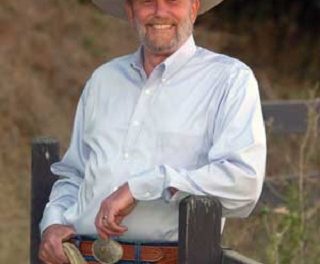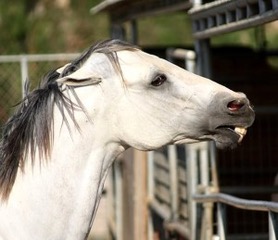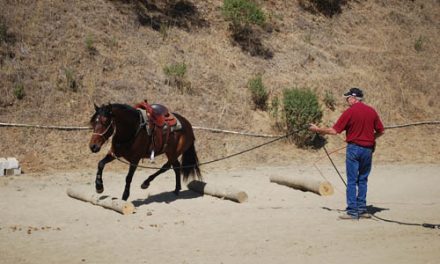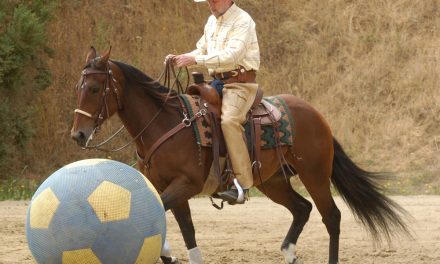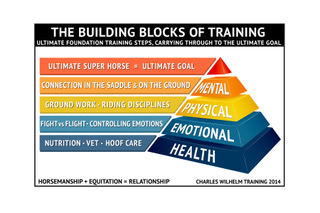
I’ve done a couple of articles on this topic but I always think this subject is worth revisiting. So what is foundation? It is the basic training that makes up the building blocks of performance. It is the point where you start with a horse and revisit to reinforce behaviors or correct them when the horse goes off track. Or, in other words, it is the skill set that makes up the foundation of all training.
The fact that horses learn by pressure/release is perhaps the most basic part and the start of foundation. I currently have a four-year old here at the ranch that in my opinion is barely halter broke. This horse leans and pulls on the lead line when I pick it up and make contact. A halter broke horse does not lean or pull, but yields to pressure. Most horses that pull back when tied do so because they never learned to yield to pressure. Or, the horse may have learned to yield to pressure but not under stress. For example, a plastic bag flies up and all training goes out the window. The horse panics and goes into flight mode. If the horse is tied, it pulls back until something breaks. The next time that happens the horse will search for the release of breaking free. Horses learn by pressure/release and however the release comes, that is what the horse will do again.
It is important to understand the concept of pressure/release because when we work with a horse it is critical to reward correct behavior by giving immediate release. This is true no matter what we are doing. In this case we are talking about the horse giving to pressure when being lead or tied. However, if I am mounted and I pick up the rein and put my leg on the horse, that also represents pressure. If that cue happens to be move the hindquarters over and pivot on the front end, the horse will search until it finds the right solution that I am willing to release on. This is the start of foundation, meaning we understand that horses learn by pressure/release.
You can teach your horse to lead, to back up on the lead, and to move over on the lead. But sometimes while leading, at the cross ties or the hitching post, the horse will move into you. You slap the horse on the belly and ask that it move over. If the horse doesn’t move and you slap it harder and it still doesn’t move away or it moves into you, the horse has not learned to yield to pressure. This horse has not had the foundation. Foundation moves are simple maneuvers that keep us safe.
The same concept applies if I am in the saddle. I ride horses here at the barn all the time that wander to the right or left when I ask them to go on a straight line. I ask these horses to go straight but they move left or right. These horses have not learned to “stay between the reins”. Going straight is a very fundamental, basic exercise that every horse should know because we want our horses to be balanced. Most of the time we think in terms of balance front to rear but balance is also important right to left. We need to pay attention to ensure the shoulder is not falling in or bulging out. When we are teaching a horse to go in a straight line, we ask that the horse do it on his own. This is a foundation principle.
When most riders ask a horse to stop, they grab the reins and pull back. Foundation is teaching the horse a finer cue. They do need to learn to stop with a rein cue but they also need to learn to stop from a body/seat cue, depending on your discipline.
The foundation is teaching the horse a series of physical cues. For example, I like to work with three spots on the side of a horse where my legs are when I am in the saddle. The first represents shoulder control, the second handles lateral work and the third position controls the hindquarters. Many riders rely on the reins to control the horse. With a more finished or advanced horse I do use my hands but the rein cue is the last cue I use. I always use my legs and seat first because horses come with resistance. You will see resistance when teaching a horse to move off your leg but also in your hands. With a bit, the horse has a tendency to brace. I just finished a warm blood horse that came into the barn for training and he was very resistant. He would tighten his neck and stick his jawbone out and brace against the bit and reins. A horse like this is very difficult to control or do anything with. He had been started by someone but obviously not someone who understood the basic fundamentals or principles.
We can call the foundation steps we put on a horse the ABCs or basic fundamentals but another way to think about it is when your child starts kindergarten. There are certain skills that children need to have to be ready for kindergarten. Hopefully we have taught them to be social and get along with other people but kindergarten is a great place for them to exercise and hone these skills. A child may have some trouble with children his or her own age but because of the foundation training the child has had he or she will be able to overcome these difficulties. The child is learning and experimenting in the world and may go off track but because we have taught them certain fundamentals, we can remind them and get them back on the straight path.
Horses function in much the same way. One of the reasons I got into the business of working with problem horses is that often I see horses that are asked to do high school or college level work and they haven’t even been to kindergarten. Without the basics of math we can’t do algebra and without algebra we can’t do trigonometry. My point is that there must be a good basic foundation and we must revisit it from time to time. Every time I get on a horse there are certain exercises I do that not only remind the horse of the foundation basics but also make the response to those cues better, softer, and lighter. The horse becomes more responsive and more fluid.
It is hard to go down a steep trail with a horse that is on the front end. If you have not taught your horse to be balanced and how to use its hindquarters to go down hill it will be hard on the horse and on you. If the horse does not know the half-halt cue, the ride down will also be more difficult. The half-halt is a basic fundamental that slows the horse down by repositioning the body. Conversely, a horse going up hill will often begin to trot because the horse is on the front end and is pulling itself along. The horse has not learned to come up under itself and push from behind. I would guess that about ninety-nine percent of horses do not know how to push themselves up a hill. People tell me they live in the hills or mountains and their horses go up and down all the time. Even then I see the horses pulling themselves up. From my practical experience working with a variety of breeds of horses, some very athletic and some not. The majority do not know how to carry themselves up or down a hill. Going down, they tend to do what I call short stepping, as they haven’t learned to walk out. The horse doesn’t feel comfortable going down because it is on the front end so it shortens its stride. When the horse comes from behind it is balanced and can descend faster and the ride is smoother.
These are all fundamentals and we need to make sure the horse knows these basics, and we need to review this foundation knowledge. When the foundation is in place we can do the more advanced moves like lead changes, side passes and transitions. With a solid foundation we will have a stop on the horse that we can rely on at any given time and in any situation. When someone walks into the arena without looking right or left and walks directly in front of you, you are going to have to stop quickly and your horse must respond or there is going to be an accident. You must have control of your horse even though it may be startled.
So call it foundation, the basics, or the ABCs, it must be established and reviewed all the time. Your warm up period is an excellent time to do this. The better the horse understands the foundation work, the easier it is to go through it in review. Keep these things in mind if you are out there struggling with your horse. Does your horse have a good foundation?
Does your horse…
*` Go forward, and go forward consistently
* Stop
* Travel between the reins
* Do directional work without argument
* Back up
* Respond to a half-halt
* Come through from behind when picking up a lead or climbing a hill
* Pick up a lead
* Transition up and down
These are the fundamentals that must be in place before we go on to higher levels of exercise and performance. Many trainers understand the need for foundation, as without it the horse is not going to be able to advance.

